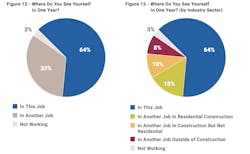Why Do Construction Workers Stay or Leave?
Given the construction industry’s much-heralded labor shortage, it can be easy to assume that higher pay is the best way to attract and keep workers. In fact, pay is not construction workers’ main motivator, according to a recent survey conducted by Building Talent Foundation (BTF).
The top reason that construction workers stay in their jobs—and also the top reason they’re thinking about leaving—involves skills development and career advancement. Over half (53%) of surveyed construction workers say they stay in their jobs because of the opportunities they have to develop their skills and careers. And almost one-third (31%) say they’re thinking about leaving their jobs because of the lack of skills development and career advancement.
Among workers’ reasons for either staying or leaving, pay/benefits ranks fourth and second, respectively. “Yes, pay is very important, but it’s not the most important,” says Branka Minic, CEO of BTF. A nonprofit founded by many of the country’s largest residential construction companies in 2019, BTF advances construction education, training, and career advancement.
WHAT MAKES CONSTRUCTION WORKERS STAY AT OR LEAVE THEIR JOBS?
From 2022 to 2024, the construction industry needs to hire an additional 2.2 million workers, according to the Home Builders Institute. In light of that need, and the industry’s difficulty meeting it, BTF wanted to study employee engagement: the level of people’s commitment and connection to their work. To better understand why people stay with or leave their jobs, BTF, in late 2021, surveyed close to 1,500 workers in residential and commercial construction, most of them frontline and the rest in back-office roles. The Oxford Centre for Employee Engagement helped conduct the research and analysis.
More highly engaged workers aren’t simply a nice-to-have, Minic points out. Companies with stronger engagement see higher productivity and profits and lower turnover, Gallup finds. “It’s not just about making people happy, it’s about making companies successful,” Minic says. And, according to the BTF report, it can cost about $15,000 to replace one worker. “There’s a high business impact from losing people.”
Another key factor in staying or quitting: how people’s immediate supervisors treat them. That’s the second top reason to stay and third top reason to leave. Close to half of respondents (45%) cite their bosses’ treatment of them as a reason for sticking with their current jobs—16 percentage points higher than those who say pay and benefits. Meanwhile, 15% cite their bosses’ treatment as a reason for quitting.
“Bad bosses are a reason people flee their jobs. Immediate supervisors have a tremendous role to play,” Minic says. “Many times companies promote someone to a supervisory position but don’t necessarily help that person become a true supervisor.”
The report’s takeaways are clear: The construction industry needs to help its people develop their skills, including leadership skills, and advance their careers.
Overall, about half (51%) of survey respondents say they’re engaged and are not looking for another job. And almost two-thirds (64%) say they see themselves in the same job in one year’s time. On the other side, over one-third (35%) say they’re not engaged and are looking for another job. Of these individuals, about half (51%) say they would leave residential construction altogether—which would be a sizable loss for the industry.
The workers most at risk of leaving, the report found, are those with only one to five years of experience. “That’s a concern because those are the people we need to count on to carry the industry forward,” says Minic, citing the construction industry’s aging workforce. While 43% of people with one to five years of experience want a different job, that’s true of about one-third of people with under one year or more than five years of experience.
Workers who are eyeing the exits also tend to come from smaller companies. Close to half (47%) of respondents who work at companies with fewer than 10 employees—but only 27% of respondents at companies with more than 100 employees—are thinking about another job. Training, especially for supervisors, is not always readily available in small firms, Minic says. “And small firms are prevalent in our industry.”
"Bad bosses are a reason people flee their jobs. Immediate supervisors have a tremendous role to play." — Branka Minic, CEO, BTF
Also at risk of leaving are women. Over one-quarter (27%) of women report they’re not engaged with their work, compared to less than one-fifth (19%) of men. “We are already struggling to recruit more women into the sector,” Minic says. “We need to be careful not to lose more of them.”
In the future, BTF intends to identify and share best practices for skills development and career progression. And it plans to provide employers with additional resources, such as training modules for supervisors, on BTF’s JobsToBuild careers platform: a jobs board and learning management system. BTF also wants jobseekers to use JobsToBuild to learn about possible construction careers—and career pathways. “It’s not always obvious to people what’s the next step in their careers, so we’re going to work hard on that,” Minic says.
To download the full 42-page report, click the download button below.


